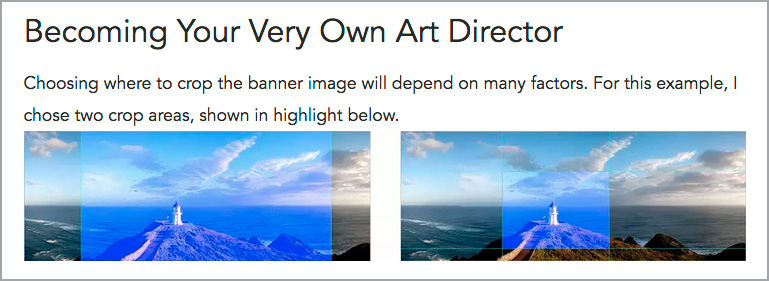In the creative community, there are discrepancies in how people use design-related lexicon. Terms like “Creative Direction”, “Asset Production”, and “Design” are often used interchangeably and inaccurately. It can be confusing.
“Art direction” in particular, means different things to different people, and there’s a recent trend in using this term to describe specific processes surrounding the production of scalable assets in responsive systems.
For example, according to the Google Developer’s documentation on responsive images:
“[c]hanging images based on device characteristics, also known as art direction can be accomplished using the picture element. The picture element defines a declarative solution for providing multiple versions of an image based on different characteristics, like device size, device resolution, orientation, and more”. – Google Developer Documentation.
Another article discussing “Art-Directed Adaptive Images” notes that “it’s easiest to make art direction choices in a bitmap editing program such as Photoshop” (Storey), followed with an example of “art direction”:

Image by Dudley Storey, Art-Directed Adaptive Images With SVG and Javascript
Changing images based on device characteristics is not an art direction problem, and the solution does not entail art directing. This is a content and layout problem, and the term “art direction” in this context is being reduced to the act of cropping and selecting images.
So, What is Art Direction?
Dan Mall’s article, “Art Direction and Design” has one of the most apt definitions of art direction:
“Art direction brings clarity and definition to our work; it helps our work convey a specific message to a particular group of people. Art direction combines art and design to evoke a cultural and emotional reaction. It influences movies, music, websites, magazines—just about anything we interact with. Without art direction, we’re left with dry, sterile experiences that are easily forgotten. Can a New York subway ad about the homeless provoke you to donate money? Why do you want to beg Clarice Starling to turn around, even though you know she can’t hear you? How do candles transform a regular meal into a romantic evening? Art direction is about evoking the right emotion, it’s about creating that connection to what you’re seeing and experiencing.
By contrast, design is the technical execution of that connection. Do these colors match? Is the line-length comfortable for long periods of reading? Is this photo in focus? Does the typographic hierarchy work? Is this composition balanced?“.
– Dan Mall, Art Direction and Design
What I Think of Art Direction
I believe that art direction should be an inherent part of the design process. The concept should drive art direction and in turn, art direction should inform design.
“Design is the how. It’s the foundation of all communication, the process and production of typography, color, scale, and placement. Art direction is the why. It’s the concept and decisions that wrap itself around the entire product. Outside of this, it’s involvement, perception, and politics.”
— Jarrod Riddle, Sr. Art Director, Big Spaceship
Using vernacular incorrectly is inevitable, especially in cross-discipline industries. It’s the concept and communication that is important and if the message gets across then there is no problem. But if words are causing confusion then it’s important that people agree on lexicon or use an established one in a consistent manner. When it comes to art direction, it is important that we acknowledge “[t]he most important aspect of art direction is the ‘concept’” (Hay, 2004). This ensures we get the most out of design and art direction, thus helping to create distinct and memorable experiences.
At gskinner we believe that great ideas can come from anywhere and we build concepts collaboratively. Designers work closely alongside developers and everyone contributes ideas. Each person has both a diverse and specialized skill set that brings new perspectives and insight to the table. A concept could come from sketching, a piece of technology, interaction design, or team brainstorming. The process of Art Direction is involved and entails much more than cropping images.
